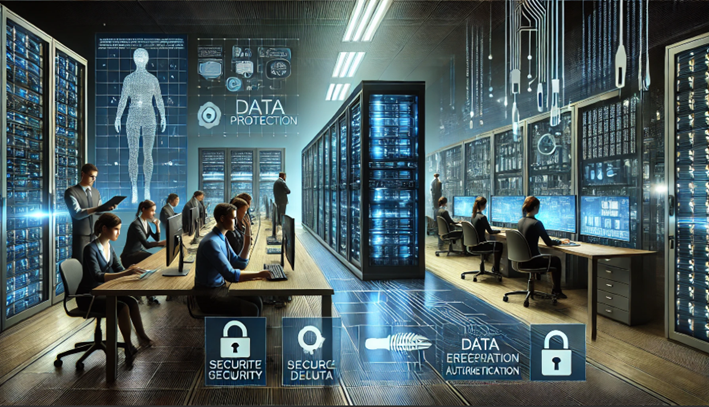
Cybersecurity & ISO 27001: How to Secure Your Business Data
In today’s digital-first world, cybersecurity threats are at an all-time high. Data breaches, ransomware attacks, and insider threats put businesses at risk of financial losses, legal penalties, and reputational damage.
To combat these risks, companies need a structured approach to information security—and that’s where ISO 27001 comes in.
ISO 27001 is the international standard for Information Security Management Systems (ISMS), providing a comprehensive framework to protect business data, manage cyber risks, and ensure compliance with global security regulations.
But how does ISO 27001 help secure your business, and why is it essential in 2025? Let’s explore.
1. Why Cybersecurity is a Top Priority for Businesses
Cyberattacks are becoming more frequent, sophisticated, and costly. Businesses face risks such as:
🔹 Ransomware attacks – Hackers encrypt business data and demand payment.
🔹 Phishing scams – Employees unknowingly share sensitive information.
🔹 Data breaches – Exposing customer and financial data.
🔹 Insider threats – Employees or partners mishandle or leak confidential information.
🔹 Regulatory penalties – Non-compliance with GDPR, HIPAA, and CCPA leads to legal fines.
ISO 27001 provides a proactive defense against these threats, ensuring data confidentiality, integrity, and availability.
2. What is ISO 27001?
ISO 27001 is an international cybersecurity standard that helps organizations:
✅ Protect sensitive business and customer data from cyber threats.
✅ Identify and manage security risks before they lead to breaches.
✅ Comply with global regulations (GDPR, HIPAA, PCI-DSS, SOC 2, etc.).
✅ Implement strong access controls and encryption methods.
✅ Ensure business continuity and disaster recovery planning.
Unlike traditional cybersecurity measures, ISO 27001 is a risk-based framework that focuses on continuous monitoring and improvement of security policies.
3. How ISO 27001 Secures Your Business Data
a) Risk Assessment & Threat Identification
ISO 27001 requires businesses to analyze risks, such as:
🔹 External cyberattacks (hacking, malware, phishing).
🔹 Internal vulnerabilities (employee errors, weak passwords, unauthorized access).
🔹 Third-party risks (vendors, cloud providers, remote access).
Businesses must document, evaluate, and address security threats proactively.
b) Strong Data Protection Policies
ISO 27001 ensures businesses implement:
✔ Access control measures – Restricting sensitive data access to authorized users.
✔ Encryption & data masking – Securing data both in transit and at rest.
✔ Multi-factor authentication (MFA) – Preventing unauthorized logins.
c) Compliance with Global Cybersecurity Regulations
ISO 27001 helps organizations align with key security laws:
📌 GDPR (Europe) – Protects personal data and privacy.
📌 CCPA (California, USA) – Regulates consumer data protection.
📌 HIPAA (Healthcare) – Ensures security of patient records.
📌 PCI-DSS (Payments) – Secures credit card transactions.
By complying with ISO 27001, businesses avoid fines, lawsuits, and data breaches.
d) Employee Cybersecurity Training & Awareness
ISO 27001 requires businesses to:
✔ Train employees on phishing, social engineering, and password security.
✔ Conduct cybersecurity drills and simulated attacks to test readiness.
✔ Establish a culture of security awareness across departments.
e) Incident Response & Business Continuity Planning
ISO 27001 ensures businesses have:
✅ Incident response plans – Quick action against cyberattacks.
✅ Backup & disaster recovery solutions – Avoiding data loss.
✅ Regular cybersecurity audits & vulnerability testing – Preventing security gaps.
By implementing these, businesses can recover quickly from cyber incidents.
4. How to Implement ISO 27001 for Maximum Cybersecurity
Step 1: Conduct a Cyber Risk Assessment
🔍 Identify potential cyber threats and data vulnerabilities.
🔍 Assess network security, cloud storage, and endpoint protection.
Step 2: Develop an Information Security Policy (ISP)
📌 Establish guidelines for password policies, device security, and data sharing.
📌 Implement role-based access controls (RBAC) to limit data access.
Step 3: Secure IT Infrastructure & Cloud Systems
✅ Encrypt sensitive business and customer data.
✅ Use firewalls, intrusion detection, and VPNs for remote work security.
✅ Implement real-time security monitoring tools for threat detection.
Step 4: Train Employees & Conduct Cyber Drills
📚 Provide ongoing cybersecurity awareness training.
📚 Simulate phishing attacks to test employee response.
Step 5: Perform Regular Cybersecurity Audits & Updates
✔ Conduct internal and third-party security audits.
✔ Update security policies based on new cyber threats and trends.
Step 6: Achieve ISO 27001 Certification
📜 Work with an ISO-certified auditor to assess compliance.
📜 Obtain ISO 27001 certification to showcase cybersecurity commitment.
5. The Future of Cybersecurity & ISO 27001
As cyber threats evolve, businesses must stay ahead of hackers and data breaches. Future trends include:
🚀 AI-driven cybersecurity – Using machine learning to detect and stop threats in real-time.
🚀 Zero Trust Security Model – Businesses moving to never trust, always verify frameworks.
🚀 Integration of ISO 27001 with other security standards (ISO 27701 for privacy, SOC 2 for cloud security).
🚀 Cyber insurance becoming essential for risk management.
By adopting ISO 27001 now, businesses can future-proof their cybersecurity strategy.
6. Conclusion: Why ISO 27001 is a Must for Businesses
Cybersecurity is no longer an IT issue—it’s a business survival necessity. Companies that ignore data security risks face:
🚨 Financial losses from cyberattacks and data breaches.
🚨 Legal fines due to non-compliance with global security regulations.
🚨 Loss of customer trust and damage to brand reputation.
On the other hand, ISO 27001-certified businesses gain:
✅ Stronger cybersecurity defenses.
✅ Compliance with global regulations.
✅ A reputation as a trustworthy, security-conscious company.
💡 Ready to secure your business data? Contact us today to implement ISO 27001 and protect your organization from cyber threats! 🔐🚀